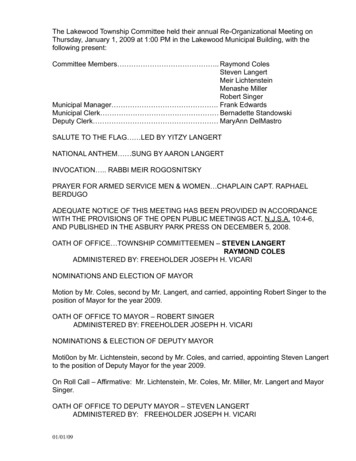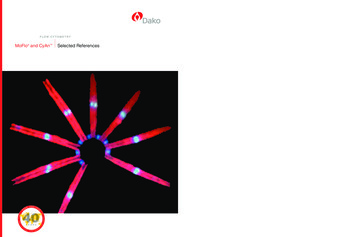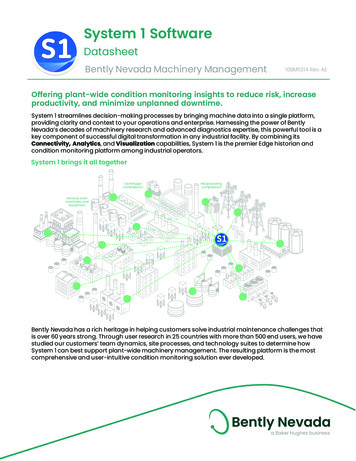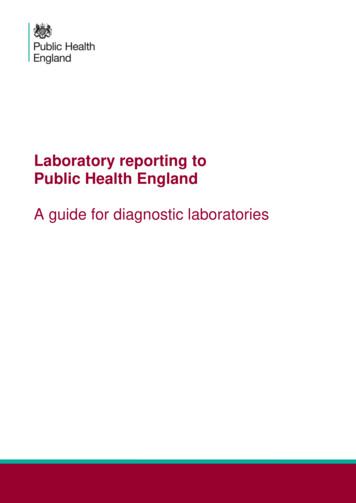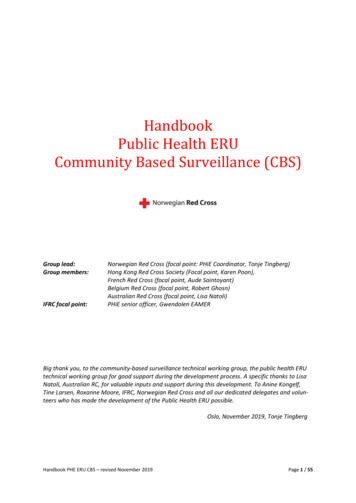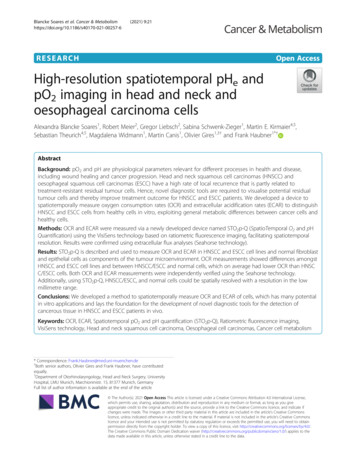
Transcription
Blancke Soares et al. Cancer & -6(2021) 9:21RESEARCHOpen AccessHigh-resolution spatiotemporal pHe andpO2 imaging in head and neck andoesophageal carcinoma cellsAlexandra Blancke Soares1, Robert Meier2, Gregor Liebsch2, Sabina Schwenk-Zieger1, Martin E. Kirmaier4,5,Sebastian Theurich4,5, Magdalena Widmann1, Martin Canis1, Olivier Gires1,3† and Frank Haubner1*†AbstractBackground: pO2 and pH are physiological parameters relevant for different processes in health and disease,including wound healing and cancer progression. Head and neck squamous cell carcinomas (HNSCC) andoesophageal squamous cell carcinomas (ESCC) have a high rate of local recurrence that is partly related totreatment-resistant residual tumour cells. Hence, novel diagnostic tools are required to visualise potential residualtumour cells and thereby improve treatment outcome for HNSCC and ESCC patients. We developed a device tospatiotemporally measure oxygen consumption rates (OCR) and extracellular acidification rates (ECAR) to distinguishHNSCC and ESCC cells from healthy cells in vitro, exploiting general metabolic differences between cancer cells andhealthy cells.Methods: OCR and ECAR were measured via a newly developed device named STO2p-Q (SpatioTemporal O2 and pHQuantification) using the VisiSens technology based on ratiometric fluorescence imaging, facilitating spatiotemporalresolution. Results were confirmed using extracellular flux analyses (Seahorse technology).Results: STO2p-Q is described and used to measure OCR and ECAR in HNSCC and ESCC cell lines and normal fibroblastand epithelial cells as components of the tumour microenvironment. OCR measurements showed differences amongstHNSCC and ESCC cell lines and between HNSCC/ESCC and normal cells, which on average had lower OCR than HNSCC/ESCC cells. Both OCR and ECAR measurements were independently verified using the Seahorse technology.Additionally, using STO2p-Q, HNSCC/ESCC, and normal cells could be spatially resolved with a resolution in the lowmillimetre range.Conclusions: We developed a method to spatiotemporally measure OCR and ECAR of cells, which has many potentialin vitro applications and lays the foundation for the development of novel diagnostic tools for the detection ofcancerous tissue in HNSCC and ESCC patients in vivo.Keywords: OCR, ECAR, Spatiotemporal pO2 and pH quantification (STO2p-Q), Ratiometric fluorescence imaging,VisiSens technology, Head and neck squamous cell carcinoma, Oesophageal cell carcinomas, Cancer cell metabolism* Correspondence: Frank.Haubner@med.uni-muenchen.de†Both senior authors, Olivier Gires and Frank Haubner, have contributedequally.1Department of Otorhinolaryngology, Head and Neck Surgery, UniversityHospital, LMU Munich, Marchioninistr. 15, 81377 Munich, GermanyFull list of author information is available at the end of the article The Author(s). 2021 Open Access This article is licensed under a Creative Commons Attribution 4.0 International License,which permits use, sharing, adaptation, distribution and reproduction in any medium or format, as long as you giveappropriate credit to the original author(s) and the source, provide a link to the Creative Commons licence, and indicate ifchanges were made. The images or other third party material in this article are included in the article's Creative Commonslicence, unless indicated otherwise in a credit line to the material. If material is not included in the article's Creative Commonslicence and your intended use is not permitted by statutory regulation or exceeds the permitted use, you will need to obtainpermission directly from the copyright holder. To view a copy of this licence, visit http://creativecommons.org/licenses/by/4.0/.The Creative Commons Public Domain Dedication waiver ) applies to thedata made available in this article, unless otherwise stated in a credit line to the data.
Blancke Soares et al. Cancer & Metabolism(2021) 9:21BackgroundHead and neck squamous cell carcinomas (HNSCCs)have a worldwide incidence of over 550,000 cases annually and cause over 380,000 deaths per year [1]. Despiteimprovements in surgical and adjuvant treatment options including laser- and robotic-based surgery [2],monoclonal antibody therapies targeting EGFR and PD1, and molecular subtyping options [3, 4], the 5-year survival rate for HNSCCs remains below 50% [1]. Thus, theclinical outcome of HNSCC patients is persistently poorin comparison to other tumour entities and further therapy improvements are in high demand.The standard treatment procedure for HNSCC patients consists of complete tumour resection, while preserving functionally essential anatomical structures.Advanced stages of the disease usually require a combination of surgery with irradiation and/or chemotherapeutic drugs such as 5-fluorouracil and cisplatin. For thesurgical removal of the tumour, a resection margin ofminimum 5 mm is recommended, and incompletetumour removal is associated with worsened survivalrates [5]. Rates of positive surgical margins (PSMs), i.e.incomplete tumour resection, range from 15 to 30% inhead and neck cancer patients [6, 7]. Incomplete tumourresection can result from topological constraints and residual tumour cells remaining undetected during surgery. That is why further improving surgical resectiontechniques is an important clinical aim in addition tobetter diagnostic tools to support therapy planning bydistinguishing cancerous tissue from healthy tissue.One of the main characteristics of cancer cells istheir highly proliferative nature, which requires themto adapt their metabolism to produce the necessaryenergy and biomass to create new progeny [8]. OttoWarburg observed that cancer cells, even in the presence of oxygen, preferentially metabolise glucosethrough “aerobic” glycolysis instead of oxidative phosphorylation [9, 10]. This allows cancer cells to surviveand proliferate in both aerobic and anaerobic conditions, which is especially relevant in solid tumours,comprised of regions of high and low oxygenation.Additionally, aerobic glycolysis indirectly provides metabolites to produce cellular building blocks, such asfatty acids and non-essential amino acids [8]. However, glycolysis results in the formation of largeamounts of lactate, mostly a waste product, whichcancer cells extrude at higher rates than normal cellsby upregulating acid extruding transporters, e.g.NHE1 and monocarboxylate transporters [11].Through this mechanism, cancer cells maintain ahigher intracellular pH (pHi) than normal cells, whichcontributes to efficient proliferation, migration, andmetabolism [12]. As a further result, the extracellularpH (pHe) of cancer cells in tumours is measurablyPage 2 of 16lower compared to non-malignant tissues with average ranges of pH 6.8–7.0 for tumour vs. 7.4 for normal cells [13, 14].Both oxygen consumption rate (OCR) and extracellular acidification rate (ECAR) are indicators of cellularmetabolic activity. They are usually determined by quantifying decreases in oxygen concentration and pH of themedium surrounding the cells over time, respectively.However, in order to distinguish cancerous from healthytissue, a diagnostic tool must provide spatial resolutionof OCR and ECAR within a tissue. In contrast toelectrode-based or soluble sensor-based tools, immobilised pH- or O2-sensitive fluorophores are suitable options for such an application. The VisiSens TD system(PreSens GmbH) in combination with pH- and O2-sensitive sensor foils facilitates spatiotemporal monitoring ofpH and O2 concentrations, both in vitro and in vivo[15–18]. In the present study, we developed a devicebased on the existing VisiSens TD camera system [19,20] that allows spatiotemporal pO2 and pH quantification (STO2P-Q). Our results show that the newly developed measurement system can detect differences inOCR and ECAR between HNSCC/ oesophageal squamous cell carcinomas (ESCC) cell lines and normal cells,which lays the foundation for the development of diagnostic tools based on the VisiSens technology.MethodsPlasmid generationmCherry was PCR amplified and cloned into the pCAG3SIP plasmid using EcoRI and NheI restrictions sites. Additionally, the promotor was changed from CMV to EF1.Cell culture and generation of transgenic cell linesFaDu, Kyse30, Cal33, and Cal27 were purchased fromDSMZ (Braunschweig, Germany), HNEpC from PromoCell (Heidelberg, Germany). HFF-1 cells were initiallyprovided by Prof. Markus Meissner and were subsequently purchased from ATCC (Manassas, USA)(SCRC-1041). FaDu cells were initially isolated fromsquamous cell carcinoma of the hypopharynx [21].Kyse30 cells are derived from a well-differentiated invasive oesophageal squamous cell carcinoma [22]. Cal27were established from a poorly differentiated squamouscell carcinoma of the tongue, and Cal33 from a moderately differentiated squamous cell carcinoma of thetongue [23]. HNEpC are primary nasal epithelial cellsisolated from healthy individuals, HFF-1 are fibroblastsisolated from the foreskins of new-born human males.All cell lines were cultured in T25 or T75 cell cultureflasks (Sarstedt AG, Nümbrecht, Germany) at 37 C, 5%CO2, and 100% humidity. Cells were grown to 70–90%confluence and then split 1:3 to 1:10, one to three timesa week. FaDu, Cal33, Cal27, and HFF were cultured in
Blancke Soares et al. Cancer & Metabolism(2021) 9:21DMEM (Gibco, Dublin, Ireland) supplemented with 10%FBS (FBS Superior, Sigma Aldrich, St. Louis, USA) and1% penicillin/streptomycin (final concentration 100 μg/ml, Gibco, Dublin, Ireland). Kyse30 cells were culturedin RPMI 1640 with L-glutamine (Gibco, Dublin, Ireland)supplemented with 10% FCS and 1% penicillin/streptomycin. HNEpC were cultured in Airway EpithelialMedium containing Supplement Mix according to themanufacturer’s instructions (PromoCell, Heidelberg,Germany).Kyse30 and FaDu cells were transfected with a pCAGEF1-mCherry expression plasmid using the MaTra Kit(PromoCell, Heidelberg, Germany) according to manufacturer’s instructions. Two days after transfection,transfected cells were selected by adding 1 μg/ml puromycin to the culture medium. After 2 to 3 weeks, the selected cells were resistant to puromycin and mCherryexpression was verified by fluorescence microscopy.O2 and pH measurements using the newly developeddeviceShort-term measurements: standard procedureEach separate batch of sensor foils (PreSens, Regensburg,Germany) was separately calibrated. O2 (SF-RPSu4NAU-L4/W4-OIW) and pH (SF-HP5R-L4/W4-US) sensor foils were provided by PreSens, Regensburg,Germany. Calibration of O2 sensor foils was performedusing a saturated solution of Na2SO3 in H2O for the 0%O2 calibration point and air saturated medium for the100% O2 calibration point. pH calibration was performedusing NaH2PO4/Na2HPO4 buffers with a buffer capacityof 40 mM, substituted with NaCl to a total ionicstrength of 140 mM with six different pH values between pH 5 and pH 8.5.To measure the oxygen consumption and extracellularacidification of individual cell lines, 4.5 104 cells wereseeded into one well of 2-well silicon inserts (Ibidi, Gräfelfing, Germany) inserted into the wells of a 6-well plate(Sarstedt AG, Nümbrecht, Germany), and cells wereallowed to attach overnight. The silicon inserts were removed and 2 ml imaging medium (RPMI 1640 withoutPhenol Red, with L-glutamine) (Gibco, Dublin, Ireland)supplemented with 10% FCS and 1% penicillin/streptomycin added to each well. The 6-well plate was thentransferred to an incubator containing the STO2p-Q device, placed on the frame and the lid replaced by a lidequipped with sensor foil-covered plungers. The sensorfoils were equilibrated in PBS for at least 1 h before eachmeasurement. Cells were equilibrated to the incubator’senvironment for 1 h before measurement was started.To start measurements, plungers were lowered onto thecells and the VisiSensVS Software (PreSens) programmed to acquire images in 10-s intervals for 30 min(pH measurements) or 20-s intervals for 60 min (pO2Page 3 of 16measurements). The exposure time was set between 400and 600 ms, the gain was set to 3, and LED intensity setto maximum.After measurement, cells were stained with 1 μg/mlHoechst 33342 fluorescent DNA staining dye for 10min. Microscopic images over the entire area of the celllayer were taken in the DAPI channel (excitation 350/50,emission 460/50) using the tile scanning function of theLASX software and a Leica DMi8 microscope (Leica,Wetzlar, Germany) with a 10 objective (HC PL FLUOTAR 10x/0.32 PH1). Nuclei were counted as describedbelow to normalise OCR and ECAR for cell numbers.Short-term measurements: inhibitor experimentsOligomycin (Abcam, ab141829, Cambridge, UK), 2Deoxy-D-Glucose (2-DG) (Abcam, ab142242, Cambridge, UK), glucose (Merck, Darmstadt, Germany), andCarbonyl cyanide-4-(trifluoromethoxy)phenylhydrazone(FCCP) (Abcam, ab120081, Cambridge, UK) were diluted in DMSO or ddH2O according to manufacturer’sinstructions. Cells were prepared according to the standard procedure described above. Drugs were added to theimaging medium and the plate incubated for 20 min onthe device’s frame before starting the measurements.pO2 measurements were performed in 20-s intervals for30 min, and pH measurements in 10-s intervals for 30min. After the measurements, nuclei were stained andmicroscopic images acquired as described above.Cell landscapesTo create two-dimensional (2D) cell landscapes with defined shapes and areas, 4-well silicon inserts and 4-wellsilicon μ-inserts (Ibidi, Gräfelfing, Germany), respectively, were inserted into 6-well plates. 7.5 104 cellswere seeded into each well of the larger silicon inserts,and between 1 103 and 8 103 cells were seeded intothe smaller silicon inserts. Cells were allowed to attachover night before the inserts were removed and 2 ml imaging medium was added to each well of the 6-wellplate. Before measurements were started, plates wereequilibrated to the incubator environment for 1 h. pHand pO2 were measured in 20-s intervals for 60 min, asdescribed above.In a second approach 200–800 FaDu or Kyse30 cellswere seeded into the wells of a 6-well plate and allowedto grow into visible colonies for 7–14 days. Two millilitres of imaging medium was added to each well beforemicroscopy, pH and pO2 measurements were performedas described above (20-s intervals, 60-min duration).To create mixed 2D cell landscapes, small drops (5–20μl) of cell suspensions of both HFF and FaDu (pCAGEF1-mCherry) or Kyse30 (pCAG-EF1-mCherry) with 1 106–2 106 cells/ml were pipetted into the wells of a6-well plate to create different patterns. After a few
Blancke Soares et al. Cancer & Metabolism(2021) 9:21minutes, the drops were connected using a 10-μl pipettip. Approximately 0.5–1 ml of medium was carefullyadded to the edge of the well around the drops to prevent evaporation. Cells were allowed to adhere overnight, and then 2 ml of imaging medium was added toeach well. Microscopic images over the entire area covered by cells were taken in phase contrast, and in theTXR channel (excitation 560/40, emission 639/75) witha 5 or 10 objective using the tile scanning functionof the LASX software and a Leica DMi8 microscope. pHand pO2 measurements were performed as describedabove (20-s intervals, 60-min duration).In a different approach 200–800 FaDu (pCAG-EF1mCherry) or Kyse30 (pCAG-EF1-mCherry) cells wereseeded into the wells of a 6-well plate and allowed togrow into visible colonies for 7–14 days. Subsequently,500,000 HFF were seeded into each well containing colonies. The cells were allowed to adhere overnight andthen 2 ml of imaging medium was added to each well.Microscopy, pH and pO2 measurements were performedas described above (20-s intervals, 60-min duration).In a third approach, 500,000 HFF were seeded into thewells of a 6-well plate, allowed to grow for 3 days andsubsequently irradiated with 35 Gy using a CIX2 cabinetirradiator (Xstrahl, Camberley, UK) equipped with a 0.5mm Cu filter. Two days later 200–800 FaDu (pCAGEF1-mCherry) or Kyse30 (pCAG-EF1-mCherry) cellswere seeded onto the HFF cell layers and allowed togrow into visible colonies for 7–14 days. Two millilitresof imaging medium was added to each well before microscopy, and pH and pO2 measurements were performed as described above (20-s intervals, 60-minduration). For all colony-based experiments colony sizeswere measured using Fiji [24].Long-term measurementsSelf-adhesive pH sensor spots (PreSens) were insertedinto 96-well plates and pre-treated with 100 μl FCS for 1h at 37 C before cells were seeded to improve cell adhesion. For O2 measurements, 96-well plates with the entire bottom consisting of O2 sensor foil material wereequilibrated with 100 μl PBS for 1 h at 37 C. PBS andFCS, respectively, were removed and pH sensors washedwith PBS once before seeding cells.To compare the pH and pO2 in FaDu cell cultures depending on cell numbers, 5000, 10,000, 20,000, 40,000,and 60,000 FaDu cells were seeded into 96-well platedequipped with pH sensor spots or with the bottom consisting of O2 sensor foil. For each cell number, six wellswere used, i.e. six technical replicates. To compare celllines, 40,000 cells of FaDu, Kyse30, Cal33, Cal27, HFF,and HNEpC were seeded into six wells each (six technical replicates). O2 and pH calibration buffers were included for each separate batch of sensor foils, asPage 4 of 16described above. The 96-well plates containing the cellswere sealed with a gas permeable foil (Biozym, 600295,Vienna, Austria) to prevent evaporation and left in thelaminar flow cabinet for 1 h to improve equal distribution of cells in the wells. Plates were then placed on theframe and pH or O2 measured for 90 h in 1-h intervals.Extracellular flux analysis (Seahorse XFe96)Approximately 20 h before measurement, 4 104 cells/well were seeded into XF96 microplates in five technicalreplicates per cell line. One hour before the assay, culture medium was replaced by Seahorse assay medium(XF RPMI 103576-100, Agilent, Santa Clara, USA) containing 2 mM L-glutamine and 5 mM glucose (for OCRmeasurements). Basal OCR and ECAR, and ECAR measurements after injection of glucose (5 mM final concentration) were performed in three measurement cycles,with a mix duration of 3 min, and measurement duration of 3 min. OCR and ECAR shown here representthe basal OCR and ECAR after injection of glucose, fromthe third measurement cycle. Immediately after the assaywas run, cell numbers were imaged in each well usingHoechst 33342 DNA staining and quantified by a multiimager (Cytation1, BioTek Instruments, Winooski,USA). Metabolic activities, i.e. OCR and ECAR, werenormalised to the respective cell number and calculatedper 104 cells.Software, data analysis, and statisticsOCR and ECAR calculation from short-term measurementsAfter the application of a noise filter and the sensor calibration using the VisiSensVS software, regions of interest (ROI) were drawn around areas that corresponded tothe cell layer, and pO2 concentrations over timeexported to a data frame using the “multi-z” tool. ForpH measurements, noise filter and sensor calibrationwere performed using the VisiSensVS software. The images and calibration files were then imported into theVS Live Plugin (Release 0.4.7) (PreSens, Regensburg,Germany). ROI were drawn and pH values over timeexported to a data frame. pH and pO2 were plottedusing R [25] and the R package ggplot2 [26]. A linear regression was calculated for the linear range of the pHand O2 curves. The respective slopes of the regressionlines represent the decrease of O2 concentration or pHover time (%O2/s and pH/s), thus the OCR and ECAR.To normalise for cell numbers, the slope was divided bythe respective cell numbers calculated from fluorescentimages of the cells’ nuclei and multiplied by a factor of107 (for OCR) and 104 (for ECAR) to improve the wayof representation of the data, as indicated in the respective figures. The normalised OCR and ECAR were plotted as dotplots using R and ggplot2.
Blancke Soares et al. Cancer & Metabolism(2021) 9:21Analysis of long-term measurementsAfter data acquisition, noise correction and sensor calibration were performed using the VisiSensVS software(PreSens, Regensburg, Germany). Image and calibrationfiles were then loaded into the VDT 96-well Extractorprogramme (PreSens, Release 0.3.1.2). A one-point adjustment (“OPA”) was performed using an image of aplate with the same pO2 or pH in all wells to correct foruneven illumination of the plate. pO2 and pH valueswere then automatically exported to a CSV file. Themean and standard deviation were calculated and datawere plotted as line graphs using R and ggplot2.Quantification of cell numbersSixteen-bit greyscale images obtained by fluorescencemicroscopy were loaded into CellProfiler [27] and nucleidetected using the module “IdentifyPrimaryObjects” withadvanced settings that were adjusted according to fluorescence intensity, nuclear size, and density of cells.Image processing and figure preparationFor micrographs shown in this paper, contrast was adjusted linearly and scale bars and labels added using Fiji[24]. Figures were assembled and overlays drawn usingInkscape [28].Statistical analysesAll statistical analyses were performed using R and thepackage rstatix. To determine differences between different groups, one-way ANOVA tests with post hoc TukeyHSD were performed. Differences were considered to bestatistically significant when p 0.05.ResultsFluorescence-based spatiotemporal measurement of O2consumption and extracellular pH in HNSCC cellsTo measure O2 consumption and extracellular acidification in cell cultures, we developed a device for the spatiotemporal pO2 and pH quantification in adherent cellcultures in a 6-well format (STO2p-Q). STO2p-Q enablesa temporary reduction of the media volume surroundingthe cells, creating a micro-respirator and subsequentmeasurement of the pO2 or pH in the cellular microenvironment by lowering sensor foil-equipped plungers ontothe cells in each well simultaneously. The plungers consistof metal discs (weight 4 g), connected to strings that arerouted through the lid of a 6-well plate and attached to aplastic lid that can be lowered and lifted through an attached string routed through a loop and then through thedoor of a cell culture incubator. This facilitates the operation of STO2p-Q in an incubator without disturbing theenvironmental conditions, i.e. temperature and CO2 concentration. Within the incubator, the measurement plateis placed on a frame that facilitates the excitation andPage 5 of 16detection of the fluorescence from below using the VisiSens TD camera readout device. LEDs facilitating excitation were attached to the frame (Fig. 1a).To test if STO2p-Q enables accurate measurements ofOCR and ECAR, effects of known disruptors of mitochondrial respiration and glycolysis, respectively, weremeasured in a HNSCC and ESCC cell line, respectively.FaDu and Kyse30 cells were seeded into one well of 2well silicone inserts, inserted into a 6-well plate, andallowed to attach and form a confluent layer. After theaddition of the inhibitors, pO2 and pH measurementswere performed as described in the methods section.FCCP is an uncoupler of mitochondrial oxidative phosphorylation and is expected to increase cellular oxygenconsumption, while oligomycin, an inhibitor of H ATPsynthase, inhibits mitochondrial respiration and thus isexpected to decrease cellular oxygen consumption. InFaDu cells, addition of 1 μM FCCP increased the cells’oxygen consumption compared to the DMSO control,while the addition of 1.5 μM oligomycin decreased theOCR significantly compared to the FCCP treatment(Fig. 1b). In Kyse30 cells, the effect of the inhibitors wasmore pronounced, with FCCP significantly increasingand oligomycin significantly decreasing the OCR compared to the DMSO control (Fig. 1c).To manipulate the glycolysis rate and thus lactate production and subsequent extracellular acidification, 2-DGand oligomycin in combination with glucose were used. 2DG is a glucose analogue that competes with glucose forphosphoglucoisomerase but cannot be metabolised, thusinhibiting glycolysis. Oligomycin blocks mitochondrialrespiration and in the presence of glucose is expected toincrease the ECAR. In FaDu cells the addition of 3 μM oligomycin and 10 mM glucose caused an increase in theECAR, while 50 mM 2-DG resulted in a lower ECARcompared to the DMSO control, however not statisticallysignificant (Fig. 1d). In Kyse30 cells, the measurementswere more variable with the only statistically significantdifference observed between cells treated with 2-DG andoligomycin and glucose, with oligomycin and glucoseshowing a significantly higher ECAR (Fig. 1e).The results demonstrate that STO2p-Q in combinationwith the here established data analysis pipeline is able todistinguish differences in OCRs and ECARs betweencells treated with different compounds.Differences in ECAR and OCR between HNSCC cell linesand healthy cellsOne of our aims was to develop a method to distinguishhealthy tissue from cancerous tissue in patients withHNSCCs. As a first step, we explored potential differences in OCR and ECAR between HNSCC/ESCC cellsand normal cells in vitro. In order to identify potentialdifferences, three established HNSCC cell lines (FaDu,
Blancke Soares et al. Cancer & Metabolism(2021) 9:21Page 6 of 16Fig. 1 Introduction of the STO2p-Q method. a Schematic representation of STO2p-Q for the measurement of OCR and ECAR. Through lowering ofsensor foil-equipped stamps, a micro-respirator is generated facilitating fast measurements of OCR and ECAR. OCR measured using STO2p-Q of FaDu(b) and Kyse30 (c) cells treated with 1.5 μM oligomycin (Oligo) and 1 μM FCCP and DMSO (1:10,000). OCR was normalised by dividing the OCR(decrease of pO2 (%)/time (s)) by the cell number and multiplying with a factor of 107 (normalised OCR). n 4, from independent experiments. ECARmeasured using STO2p-Q of FaDu (d) and Kyse30 (e) cells treated with 3 μM oligomycin and 10 mM glucose (Oligo Gluc) and 50 mM 2-Deoxy-DGlucose (2-DG) and DMSO (1:5000). ECAR was normalised by dividing the ECAR (decrease of mpH/time (min)) by the cell number and multiplyingwith a factor of 104 (normalised ECAR). n 5, from independent experiments. Data was plotted as dot plots, horizontal black line indicates the mean.Statistical analysis was performed to compare different treatment groups (one-way ANOVA with post hoc Tukey HSD). *p 0.05, **p 0.01, ***p 0.001, ****p 0.0001
Blancke Soares et al. Cancer & Metabolism(2021) 9:21Cal33, Cal27), one ESCC cell line (Kyse30), and two normal cell lines (human foreskin fibroblasts, HFF; primaryhuman nasal epithelial cells, HNEpC) were measuredusing STO2p-Q equipped with O2 or pH sensor foils asdescribed. In Kyse30 cells, the measured OCR was significantly higher than in all other cell lines. FaDu cellsdisplayed the second highest OCR, differing significantlyfrom Cal33, Cal27 and the two normal cell lines, HFFand HNEpC, both of which showed the lowest OCR.The OCR of Cal33 and Cal27 did not differ significantlyfrom HFF and HNEpC (Fig. 2a). To verify our resultsobtained by STO2p-Q, we performed OCR measurements in all cell lines via the established method ofextracellular flux analysis using the Seahorse technology.The results obtained from the Seahorse measurementsreflected the results obtained by our method in thatKyse30 displayed the highest basal OCR, followed byFaDu and Cal27, and showing significantly higher OCRthan HFF and HNEpC cells. However, in the Seahorsemeasurements Cal33 showed a significantly lower OCRthan HFF and HNEpC (Fig. 2b).Using STO2p-Q, the pH measurements showed a significantly higher ECAR in HNEpCs compared to allother cell lines except FaDu, while HFFs exhibited thelowest ECAR. Differences between HFF and HNSCC celllines were not statistically significant; however, a tendency for higher OCR, especially in Kyse30 and FaDu,compared to HFF was detectable (Fig. 2c). The resultsfrom the Seahorse measurement confirmed a low ECAR(in the presence of 5 mM glucose) in HFFs, which differed significantly from all other cell lines, while therewas no significant difference between the HNSCC/ESCCcell lines (Fig. 2d), comparable to the results obtainedwith STO2p-Q.Spatial discrimination of different cell lines based on O2consumptionDetection of the spatial distribution of tumour cells andhealthy cells is particularly relevant for clinical applications. To test the ability of STO2p-Q to identify areascontaining tumour cells and to define the detection limitand resolution, different 2D-patterns of cells (“landscapes”) were created. O2 concentrations in the cellularlandscapes were measured using the device equippedwith O2 sensor foils. First, HNSCC/ESCC cells and normal cells were seeded into 4-well silicon inserts with agrowth area of 0.35 cm2/well and with each well containing a different cell type (Fig. 3a). After removal ofthe silicon inserts, measurements were performed. Thewells containing Kyse30 and FaDu cells could be identified after 2 min based on the O2 heat maps and after 12min the outlines of the areas containing FaDu andKyse30 cells were clearly detectable (Fig. 3a). Areas containing Kyse30 cells were characterised by the lowest O2Page 7 of 16concentration, followed by FaDu, Cal27, Cal33, HNEpC,and HFF, reflecting the previous results from measurements of individual cell lines (see Figs. 2a and 3a).Next, we were interested in defining an approximatedetection limit for HNSCC/ESCC cell densities based ontheir OCR. Therefore, different cell numbers between1000 and 8000 cells of FaDu, Kyse30, Cal22, and Cal27were seeded into 4-well silicon μ-inserts with a growtharea of 0.03 cm2/well. O2 concentrations were measuredafter removal of the silicon insert. Exact cell numberswere determined subsequently by fluorescence micros
head and neck cancer patients [6, 7]. Incomplete tumour resection can result from topological constraints and re-sidual tumour cells remaining undetected during sur-gery. That is why further improving surgical resection techniques is an important clinical aim in addition to better
